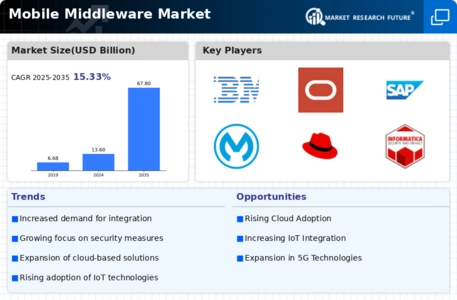Focus on Enhanced User Experience
The emphasis on delivering enhanced user experiences is a significant driver for the Mobile Middleware Market. As competition intensifies, businesses are prioritizing user satisfaction and engagement. Middleware solutions play a vital role in ensuring that mobile applications provide smooth and responsive experiences. By enabling efficient data exchange and integration, middleware helps organizations create applications that meet user expectations. Market trends suggest that companies investing in user experience are likely to see improved customer retention and loyalty, thereby fueling demand for middleware solutions in the Mobile Middleware Market.
Shift Towards Cloud-Based Solutions
The transition to cloud-based solutions is reshaping the Mobile Middleware Market. Organizations are increasingly adopting cloud technologies to enhance scalability, flexibility, and cost-effectiveness. Middleware that supports cloud integration is essential for businesses looking to leverage cloud capabilities while maintaining seamless communication between mobile applications and cloud services. The cloud services market is projected to grow substantially, indicating a strong demand for middleware solutions that facilitate this transition. This shift towards cloud-based architectures is likely to drive innovation and growth within the Mobile Middleware Market.
Demand for Real-Time Data Processing
The growing need for real-time data processing is a crucial factor propelling the Mobile Middleware Market. Organizations are increasingly relying on real-time analytics to make informed decisions and enhance operational efficiency. The ability to process data in real-time allows businesses to respond swiftly to market changes and customer needs. As a result, middleware solutions that support real-time data integration and processing are in high demand. Market data indicates that the real-time analytics market is expected to grow significantly, further driving the need for advanced middleware solutions in the Mobile Middleware Market.
Emergence of IoT and Connected Devices
The proliferation of Internet of Things (IoT) devices is significantly influencing the Mobile Middleware Market. As more devices become interconnected, the need for middleware that can manage data flow and communication between these devices is becoming increasingly critical. It is estimated that by 2025, there will be over 75 billion connected devices worldwide. This surge necessitates robust middleware solutions that can handle the complexities of data integration and processing. Consequently, the Mobile Middleware Market is likely to experience substantial growth as businesses seek to leverage IoT capabilities through effective middleware solutions.
Rising Adoption of Mobile Applications
The increasing adoption of mobile applications across various sectors is a primary driver for the Mobile Middleware Market. Businesses are increasingly recognizing the need for mobile solutions to enhance customer engagement and streamline operations. According to recent data, the number of mobile app downloads is projected to reach over 250 billion by 2025, indicating a robust demand for middleware solutions that facilitate seamless integration and communication between mobile applications and backend systems. This trend suggests that organizations are investing in middleware to ensure that their mobile applications can operate efficiently and effectively, thereby driving growth in the Mobile Middleware Market.

















Leave a Comment